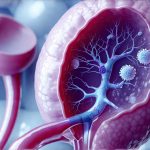Inflammation is often perceived as a negative process, linked to pain and disease, but it’s fundamentally a critical component of our immune system. It’s the body’s natural response to injury or infection, designed to eliminate harmful stimuli and initiate healing. However, when inflammation becomes chronic – persistent and ongoing – it can contribute to a wide range of health problems, impacting everything from cardiovascular health to autoimmune diseases. Understanding the role of inflammation is therefore key to understanding many common conditions, including those affecting the urinary tract. This article will delve into the intricate connection between inflammation and cystitis, exploring how this often-misunderstood condition develops and highlighting potential avenues for management and relief.
Cystitis, commonly known as a bladder infection, isn’t always caused by bacteria. While bacterial infections are frequent culprits, many cases of cystitis stem from non-infectious factors that trigger inflammation within the bladder lining. These can include sensitivities to hygiene products, reactions to certain medications, or even chronic stress. This makes diagnosing and treating cystitis more complex than simply prescribing antibiotics. It’s vital to recognize that persistent inflammatory signals within the bladder can create a vicious cycle, leading to ongoing discomfort, frequent urination, and significantly impacting quality of life. A deeper understanding of this interplay between inflammation and cystitis is crucial for effective management and long-term well-being. Understanding the link between blood sugar levels and inflammation is also critical when considering overall health impacts.
Understanding Cystitis & Its Forms
Cystitis manifests as inflammation of the bladder, but its presentation can vary greatly depending on the underlying cause. The most recognized form is acute bacterial cystitis, usually caused by Escherichia coli (E. coli) bacteria travelling from the digestive tract to the urinary tract. Symptoms typically include a strong and persistent urge to urinate, a burning sensation during urination (dysuria), frequent urination in small amounts, cloudy or bloody urine, and pelvic pain. This type is generally responsive to antibiotic treatment. However, there are other forms that require different approaches. Interstitial Cystitis (IC) – also known as Bladder Pain Syndrome – is a chronic condition characterized by ongoing bladder discomfort without an identifiable bacterial infection. The exact cause of IC remains unknown, but inflammation plays a central role and it’s often associated with nerve damage and changes in the bladder lining. Finally, non-infectious cystitis can be triggered by sensitivities to chemicals found in soaps, bubble baths, or even toilet paper, as well as radiation therapy or certain medications.
The complexities of IC are particularly relevant when discussing inflammation. Unlike bacterial infections where the inflammatory response is targeted at a specific pathogen, in IC, the immune system appears to misfire, leading to chronic inflammation even without an infection present. This can damage the bladder lining over time and cause significant pain. Identifying the trigger for non-infectious cystitis is also important, as eliminating the irritant can often reduce or resolve the inflammatory response. It’s important to note that self-diagnosing isn’t recommended; a healthcare professional can accurately identify the type of cystitis and recommend appropriate treatment strategies.
The Inflammatory Cascade in Cystitis
The body’s inflammatory response is a complex process involving various cells and molecules. When an irritant or infection enters the bladder, immune cells are activated and release signaling chemicals called cytokines. These cytokines attract more immune cells to the site of inflammation, creating a cascade effect. In acute bacterial cystitis, this process effectively targets and eliminates the bacteria, resolving the infection and calming the inflammatory response. However, in chronic conditions like IC, this cycle becomes self-perpetuating. The ongoing release of cytokines can damage bladder tissue, leading to increased sensitivity and further inflammation – essentially creating a feedback loop.
Furthermore, the bladder’s protective barrier – called the glycosaminoglycan (GAG) layer – is often compromised in individuals with chronic cystitis. This layer normally protects the bladder lining from irritating substances found in urine. When damaged, it allows these substances to penetrate deeper into the bladder wall, triggering inflammation and causing pain. The inflammatory response itself can further damage the GAG layer, exacerbating the problem. Understanding this interplay is crucial for developing targeted therapies aimed at restoring the bladder’s protective barrier and modulating the immune response. This highlights why treatments often differ significantly between acute bacterial cystitis and chronic forms like IC.
Recognizing Inflammatory Triggers & Modifying Lifestyle
Identifying and minimizing inflammatory triggers can play a significant role in managing both acute and chronic cystitis. – Dietary Factors: Certain foods and beverages are known to exacerbate bladder inflammation. These include caffeine, alcohol, spicy foods, acidic fruits (citrus, tomatoes), artificial sweeteners, and carbonated drinks. Keeping a food diary can help identify potential triggers. – Personal Hygiene Products: Fragranced soaps, bubble baths, feminine hygiene sprays, and even certain laundry detergents can irritate the bladder lining. Switching to fragrance-free and hypoallergenic products is often recommended. – Stress Management: Chronic stress can weaken the immune system and exacerbate inflammation. Practicing stress-reducing techniques like yoga, meditation, or deep breathing exercises may help manage symptoms.
Beyond lifestyle modifications, some individuals find relief through dietary supplements aimed at supporting bladder health. D-mannose, a naturally occurring sugar found in cranberries, is believed to prevent bacteria from adhering to the bladder wall, reducing the risk of infection and inflammation. However, it’s essential to consult with a healthcare professional before taking any supplements, as they may interact with medications or have other side effects. Pelvic floor muscle exercises can also be beneficial for managing chronic cystitis symptoms. A weakened pelvic floor can contribute to bladder instability and pain, while strengthening these muscles can improve bladder control and reduce discomfort. Understanding the difference between pressure and pain is crucial when assessing symptom severity.
The Gut-Bladder Connection & Microbiome Impact
Emerging research highlights a strong connection between the gut microbiome – the community of microorganisms living in our digestive tract – and bladder health. An imbalance in the gut microbiome (dysbiosis) can lead to increased intestinal permeability, allowing inflammatory molecules to leak into the bloodstream and potentially trigger inflammation in distant organs, including the bladder. Furthermore, dysbiosis has been linked to impaired immune function, making individuals more susceptible to infections and chronic inflammation.
Restoring a healthy gut microbiome through dietary changes and probiotic supplementation may therefore be beneficial for managing cystitis symptoms. Probiotics – live microorganisms that provide health benefits when consumed – can help restore the balance of bacteria in the gut, reducing inflammation and improving immune function. Foods rich in probiotics include yogurt, kefir, sauerkraut, and kimchi. However, it’s important to choose probiotic strains specifically targeted towards supporting urinary tract health, as different strains have different effects. Additionally, a diet rich in fiber promotes the growth of beneficial gut bacteria. Understanding the link between gut inflammation and prostatitis provides further insight into systemic inflammatory responses.
Future Directions: Targeting Inflammation & Restoring Bladder Function
Research is ongoing to develop more targeted therapies for cystitis that address the underlying inflammatory processes. One promising area is immunomodulation – strategies aimed at regulating the immune system and reducing chronic inflammation. This could involve using medications or natural compounds to dampen down the overactive immune response seen in conditions like IC. Another approach focuses on restoring the bladder’s protective GAG layer. Treatments such as hyaluronic acid instillations can help repair the damaged barrier, reducing sensitivity and pain.
Finally, neuromodulation techniques – which involve stimulating nerves to alter their activity – are being investigated as a potential treatment for chronic cystitis pain. These techniques aim to reduce nerve hypersensitivity and restore normal bladder function. While these therapies are still under development, they offer hope for individuals struggling with persistent cystitis symptoms. Ultimately, managing cystitis effectively requires a holistic approach that addresses the underlying causes of inflammation, restores bladder health, and supports overall well-being. A collaborative partnership between patients and healthcare professionals is essential to navigating this complex condition and achieving optimal outcomes.





















